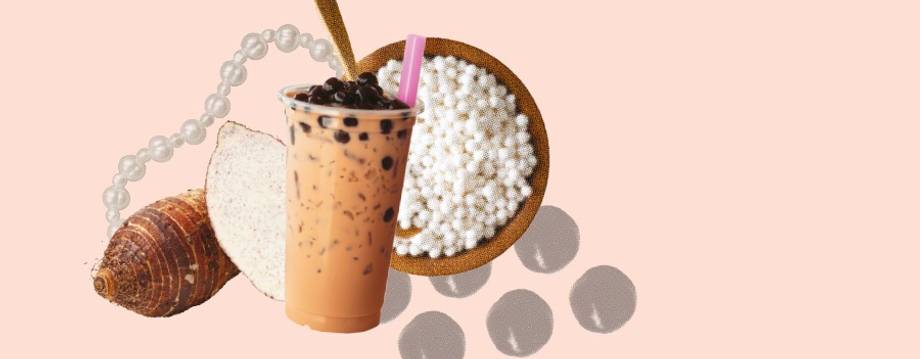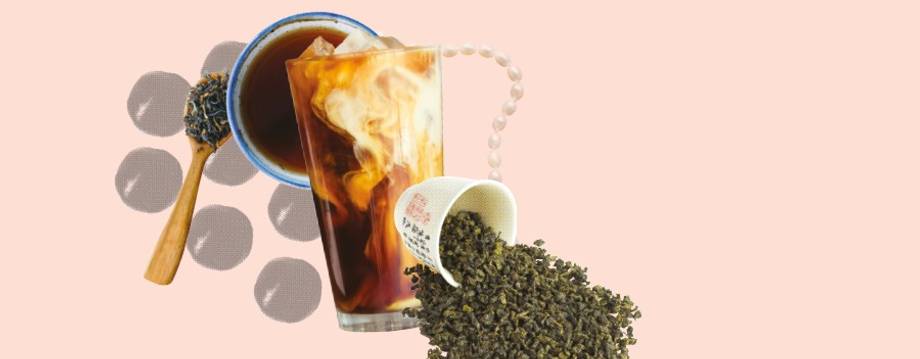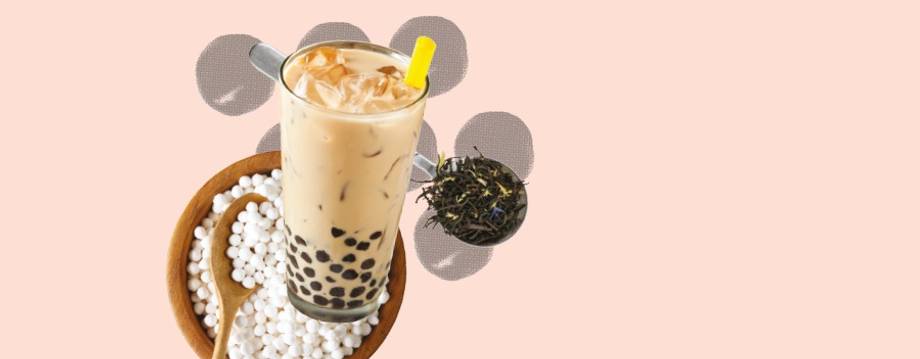Devour the world: Bubble tea
Bubble tea has come a long way from its humble beginnings in a Taichung teahouse. Melissa Cole takes a look at this worldwide phenomenon, with the help of some people who know it intimately.
Melissa Cole
Saturday 31 May 2025

This article is from
Taiwan
issue 118
Share this article
The drink itself has many names, from bubble tea to boba and pearl milk tea, its scope a testament to how global it has become. But for the purposes of this article, I’m going to use ‘boba’ to reference chilled milky tea served with tapioca or taro-based beads bouncing around at the bottom of the cup.
Interestingly, while taro is native to Taiwan, tapioca isn’t; it actually comes from South America and was introduced to the island in the mid-1900s. If you’ve never had tapioca puddings or pearls, it can be an acquired texture to the Western palate. Sam Hsih, a Taiwanese blogger and content creator from Manchester, explains that in Taiwan, “we have a specific word for the texture of tapioca balls, which is ‘Q’, or ‘QQ’. It’s like a combination of chewy & bouncy but that’s not a perfect translation.”
Perfect or not, you get the picture, but what is the history of bubble tea exactly? Just like the Minneapolis Juicy Lucy burger wars, the row over who invented chicken tikka masala or which culture has the right to lay claim to baklava, there is more than one origin story when it comes to boba. I’m going to focus on the most widely accepted one, that the drink originated in Chun Shui Tang in Taichung, though I acknowledge there are some who say it was actually created at the Hanlin Tea Room in Tainan.
Speaking to the BBC Radio programme Witness History, Liu Han-Chieh, the owner of Chun Shui Tang, tells of how, as a child, he observed his father as a very serious man. The only thing that would make him smile was tea, which imbued Liu with a lifelong interest in the drink. He decided to make it his career, and after a few decades of hard work had a successful tea business.

During a summer visit to hot and sultry Osaka, Japan, Liu was in a tea house and observed his friend’s iced coffee being made in a cocktail shaker. He asked if he could have a tea made that way… it did not go down well.
On returning to his own tea emporium he tried it himself, liked it, and set up a bar to sell frothy iced tea, sometimes with acidic fruits, other times with added alcohol, which earned the name ‘champagne tea’. It went down extremely well, so much so that his side hustle quickly outstripped the original business.
Then, in 1986, Liu’s assistant Lin Xiuhu, who was in charge of procurement and innovation for the company, was on a research visit to the local market and saw one of her favourite snacks. She brought kilos of tapioca balls back to the bar to experiment with adding texture to the smooth milky tea. She served it to her colleagues and it went down a storm. When Liu tried it, he too was convinced.
It went to market in 1987, and Liu named it pearl milk tea because he thought the tapioca spheres looked beautiful, like black pearls, and wanted the tea to have a similarly opulent name. He never expected it to generate any long-term business but the craze took off in ways he could never have expected. He quickly became famous, with stars like Michael Jordan and Jackie Chan visiting his shop to try it. Where Liu’s father had previously disapproved of his son’s business, the enormous success of pearl milk tea even saw the two reconcile.
In Taiwan, you can walk every five steps and see a boba tea shop, but there the tea is the really important part, whereas in the west it’s popping the pearls and the flavourings that stand out the most
Franchises of Liu’s spin-off company TP Tea are now opening all over the world, and thousands of imitators follow in his footsteps. Thanks to him, the bubble tea market is estimated to reach in excess of £3bn globally by 2030.
However, as Taiwanese American food writer and author of Made in Taiwan: the food of a proud island nation, Clarissa Wei says, there is a lack of understanding of commercial boba in the marketplace.
“For Taiwanese people, there's definitely a sense of pride around boba being on the international stage. Though as a food writer and researcher, I'm amused by how little people know about the ingredient as a whole. There's this perception that it's made out of pure tapioca starch, which is not true at all. It's a mixture of starches and additives, which gives it its signature bouncy texture.
“There’s not much public awareness around the ingredient itself. A truly high-quality boba made with pure tapioca starch only lasts two to three days and must be refrigerated before cooking. Most of the dried and imported versions on the market are filled with additives to extend shelf life. In that sense, a shelf-stable ‘healthy’ boba is almost an oxymoron. But I think any controversy around boba isn’t really about health — it’s about what the drink symbolises. People aren’t necessarily engaging with the quality of the ingredient; they’re engaging with boba as a cultural touchstone, a way to express identity.”
Wei says people’s lack of interest in the origins of the product has been a missed learning opportunity: “I don't think the average consumer thinks about the origin of boba, though there has been a wave of awareness surrounding it over the last couple of years. In the West, it's seen as a symbol of a proud pan-Asian identity.”

It’s something that Taiwanese-born food blogger and content creator Sam Hsih (@foodjunkieuk) echoes with her thoughts on the differences between boba in its home market and how it’s morphed as it’s spread across the world.
“In Taiwan, you can walk every five steps and see a boba tea shop, but there the tea is the really important part, whereas in the West it’s popping the pearls and the flavourings that stand out the most.
“Tea is a very big part of the culture and it comes from Chinese heritage. The older generation drinks it from small teapots and tea cups and has it by itself, to entertain people. Tea is easy to grow in Taiwan, as it has lots of mountains, with green tea and oolong being most popular. Ali’s Mountain is where they grow tea the most.”
So, next time you seek out a bubble tea, maybe you could look for a place that puts the tea first and perhaps whilst you’re chasing those elusive little popping nuggets at the bottom of your cup, you could get a little closer to its roots by reading up on what’s going on in Taiwan; after all, we are an island of tea and culture too.
Tapioca pearl milk tea recipe
This comes from Clarissa Wei’s amazing Made in Taiwan: recipes and stories from the Island Nation, published by Simon & Schuster and is widely available.

INGREDIENTS:
FOR THE MILK TEA:
- ½ cup (14 g) loose-leaf black tea
- Nondairy coffee creamer, or any type of milk to taste
- Coarse raw sugar, such as demerara, to taste
FOR THE PEARLS:
- 1 cup (120 g) tapioca starch
- ¼ cup (40 g) sweet potato starch
- 1 tablespoon dark brown sugar
- ½ cup (120 ml) warm sugar syrup
- Ice cubes (optional)
SPECIAL EQUIPMENT:
- Clean compost sieve, pizza pan with holes, or a colander with distinct large holes (the holes should be 3 mm wide)
- Spray bottle filled with water
METHOD:
MAKE THE MILK TEA:
In a pot set over high heat, warm up 1.6l water. When the water just begins to boil, add loose-leaf black tea. Turn off heat, cover, and wait until water is a lovely amber red, about 5 to 6 minutes. Strain tea through a fine-mesh sieve into a heatproof jug. Add coffee creamer/milk and sugar, to taste. Mix thoroughly and chill in fridge
MAKE THE PEARLS:
In a large, wide stainless steel mixing bowl, combine tapioca starch, sweet potato starch and dark brown sugar.
Stir thoroughly so the starches and sugar are completely mixed together (this is important, or the pearls won’t form).
Slowly drizzle 90g water into the bowl with the starch and, with your palm and fingers outstretched, rub the starch in a sweeping circular direction against the side and bottom of the bowl with your palm until little pearls begin to form, 5-10 minutes. If some of the starch begins to stick to the sides and bottom of the bowl, just gently push it off.
Continue to spritz water on the starch with a spray bottle as you go. If it gets too wet, add more tapioca starch. Pour the formed starch pearls over your sieve/colander, set over a large baking tray, and shake. The finished pearls will stay on top of the sieve, and the rest of the starch will fall into the baking tray. Pick out any abnormally large pearls and crumble them back into the mixing bowl.
Transfer finished pearls to a large bowl. Transfer excess starch back into the large mixing bowl and repeat process over and over again until most of the starch has been processed into pearls. This can take up to 30 minutes. The pearls won’t be completely uniform in shape, but they should all relatively be the same size.
When all the pearls have been formed, bring a large pot of water to a boil over medium-high heat. Pour the pearls in and cook for five minutes or so, stirring occasionally, until the outer shells of the pearls begin to turn translucent. Turn off the heat, cover the pot, and steep for an additional 10 minutes.
Remove the pearls from the pot with a spider strainer and plop them directly into the warm sugar syrup, adding more syrup if you need, infuse for at least 5 minutes.
TO SERVE: Divide the pearls into large serving cups. Add ice cubes into the cups if you’d like. Pour in the milk tea. Enjoy immediately.
NOTE: Do not refrigerate the pearls. Homemade pearls stiffen up in cold temperatures.
Share this article
